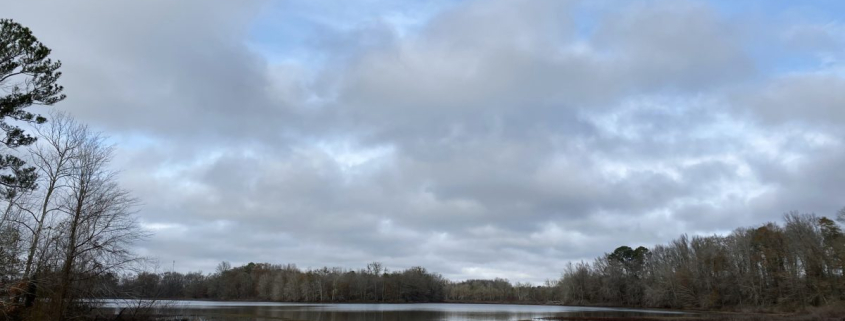Early Winter Hiking a New Trail at the Wheeler National Wildlife Refuge
December 10, 2022, I hiked a new trail, simply referred to as the Hiking and Biking Trail, that begins near the Refuge entrance gate for the Visitors Center. Fellow Nature enthusiasts Chris Stuhlinger, Jim Chamberlain, and Ed Mullin accompanied me. The flat, hard-packed fine gravel path winds through the deliciously varied habitat of mixed pine/hardwood uplands, riparian hardwood bottomlands, cropped fields and meadows, flooded wetlands and ponds (like Dinsmore Slough), and the actual channel of Flint Creek. This Post offers observations, reflections, 20 photos, and one short video.
I issued a related brief Post on our pre-hike visit to the nearby two-story observation building, and the new wildlife photo blind, all in the vicinity of the Refuge Visitors Center, closed this winter for renovations: https://stevejonesgbh.com/2023/02/22/december-10-2022-the-cranes-are-back-at-wheeler-national-wildlife-refuge/
I will also issue a Post presenting the mosses, lichens, and mushrooms we encountered on the Hiking and Biking Trail.
The Trail
We covered 5.5 miles through varied habitat and transitional weather. The day began in the upper 40s with fog and low stratus, which lifted and broke by mid-morning, replaced mid-day by thickening clouds moving in with an approaching cold front. Associated rain arrived shortly after I returned home at 2:00 PM, dropping 0.70 inches into the overnight hours. Our timing proved fortuitous for enjoying a Saturday morning outdoors.
I do not intend to introduce the trail step by step nor in sequential order. This stretch (photo below) depicts an edge (an ecotone) between closed forest cover on the right and cropland at left. Refuge managers devote significant acreage to crop production through Cooperative Farming:
Cooperative farming is a mutually beneficial arrangement where the farmer is allowed to farm refuge land under certain guidelines and restrictions, including location of crops, techniques, crops planted, and chemicals used. Wheeler NWR has an active cooperative farming program in which about 3,000-3,900 acres are planted annually. The goal of the program is to provide food and cover for migratory birds and other resident wildlife. The program supplements natural foods with grain crops, such as corn, milo, small seeded millets, and green browse. It is designed for farmers to buy the seed, plant, grow, and harvest the crop and leave a certain portion or share for the wildlife. Corn is usually chosen for refuge shares, although millet is planted in areas that remain wet too long for corn production. (From the WNWR website.) This field produced corn during the summer of 2022.
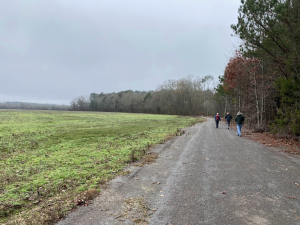
Some former agricultural lands have regenerated to forest. This upland pine stand appears to be 12-15 years old. I saw no evidence of planting (trees in rows), yet all stems seemed to be the same age. Therefore, I believe the stand either regenerated naturally, yet I did not see an evident seed source, or perhaps originated from aerial- or tractor-dispensed seed? Converting some acreage from marginal cropland to native loblolly falls within the Refuge mission to provide diverse habitat for wildlife.
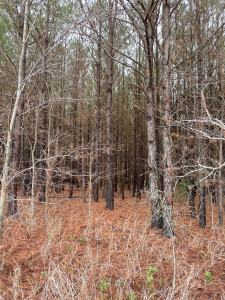
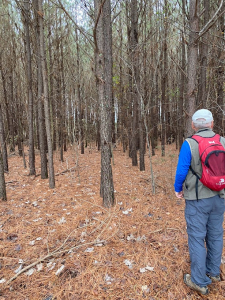
I offer these photographs to both depict the typical mature riparian forest type we traversed and to highlight these field-edge oaks that over the decades have reached toward the sunlight available on the open field side.
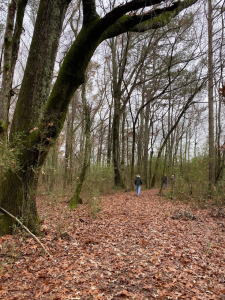
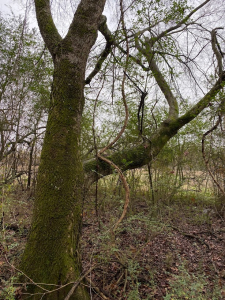
A predominantly pine with mixed hardwood upland rises beyond Ed below. Dominant pine heights exceed 100 feet.
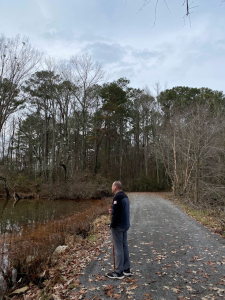
We hiked past several Waterfowl Impoundments, like the one to the left above:
Wheeler NWR manages 16 impoundments to provide approximately 2,000 acres of waterfowl habitat in open water, moist soil, and in areas where agricultural crops can be flooded. Management consists of manipulating water flows through 20 water control structures (WCS) consisting of concrete and/or corrugated metal pipes with flash board riser or screwgate structures. By adjusting the height of the control mechanism (screwgates and riser stoplogs), water levels are set and gravity-induced water flows can be created.
Generally, impoundments are filled in the fall by rainfall or through spring seepage. Rarely can the refuge open WCSs and allow water to flow from the Wheeler Reservoir into the impoundments because the reservoir’s water level has dropped (early to mid-September) prior to the time when filling is needed (late September or early October). Impoundments are not filled with water until farmers harvest crops and just prior to the time birds begin to arrive at the refuge.
Most impoundments, with the exception of the Display Pool at the Visitor Center, can usually be drained or partially drained by gravity into the reservoir or its tributaries before the water level is raised in the spring (early to mid-April) by opening various WCS. A portable pump is used to empty the Display Pool. Impoundment drawdown is initiated after waterfowl leave, generally in late February or March, depending on the impoundment and yearly conditions. In typical years, water has to be pumped out of the impoundments after the reservoir is raised in mid-April.
Impoundments and related structures are maintained annually as resources and conditions permit. When soil conditions are dry enough, unwanted vegetation (especially woody vegetation) is mowed, disced, or removed. Roadsides and the upper, dryer portion of the dikes are mowed annually. Areas that are farmed do not require as much maintenance.
I snapped the photos below from the Dinsmore Slough Road, which through this section is the Hiking and Biking Trail. The views are, respectively, to the west (left) and east. A Water Control Structure separates the two.
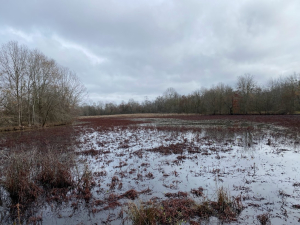
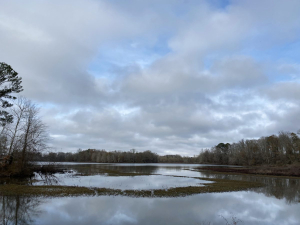
My 2:16 video elaborates on these impoundments at Dinsmore Slough:
I learned a great deal about the Refuge by walking the trail and then preparing the narrative for this Post. For starters, I now know that the Refuge includes some 4,000 acres in Cooperative Farming and 2,000 acres in Waterfowl Impoundments.
This impoundment (left), with a pumping station (off camera), was draining to its managed winter level by gravity into Flint Creek (right), which in the image is flowing from right to left toward Lake Wheeler. The impoundment water is entering Flint Creek from the culvert outlet under the gravel. I had measured in excess of six inches of rain during the two weeks prior to our hike, sufficient to bring the impoundment to targeted brimful. We had experienced below average rainfall from late summer through mid-November, likely necessitating pumping water from Flint Creek by late October to flood the impoundment. We have since gone from rainfall famine to feast.
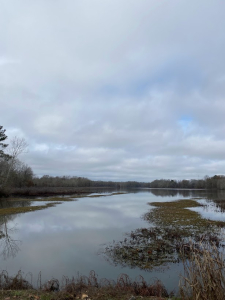
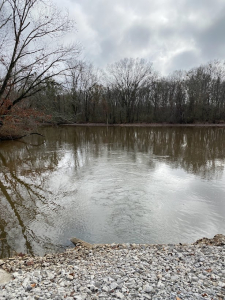
The photo above right shows the strong outlet current at the gravel edge. Although I was unable to secure a decent photograph, we watched a constant school of 2-3-inch minnows swimming in the immediate outlet flow…thousands of them, we supposed, feeding on sustenance suspended in the impoundment outflow. Larger fish worked the minnows constantly, splashing in pursuit, occasionally sending minnows airborne! Oh, the advantages of residing higher on the food chain!
Tree Form Oddities and Curiosities
As is my routine, I stayed alert for tree form curiosities and oddities. A trailside black cherry long ago suffered a blow at five feet from the ground, knocking its then sapling stem to horizontal. The flattened stem responded by activating a dormant but at the impact point, generating a vertical main stem that rose into the main canopy. Another bud sprouted at about four feet from the main stem. That branch rises only into the intermediate canopy. Some would suggest that this is an Indian pointer tree. Sorry, this individual is a natural phenomenon. Native Americans had exited this part of the Tennessee Valley at least 100 years before this Refuge forest regenerated.

I’ve found only a few examples of the phenomenon below since beginning these Posts with retirement. Visualize an oak sapling broken at knee-height by a fallen tree or branch. Normally, standing independently, such a fractured sapling stump would either generate an adventitious bud that would sprout, develop foliage, and keep the shattered sapling alive…or simply die. Neither occured in this case.
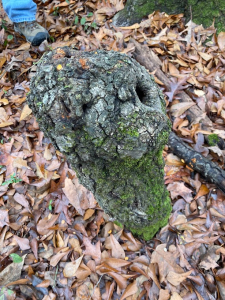
Instead, the sapling had previously root-grafted with what is now the much larger adjacent oak. The larger stem continued to grow, supported by its vibrant main canopy crown. The oak treated the grafted sapling as its own stems and branches, callousing over the wound. In effect, rather than a trunk branch stub, the calloused sapling rises from the ground attached at the root graft.
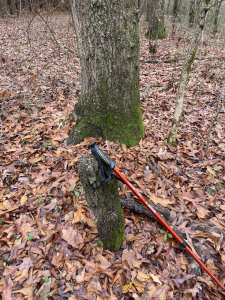
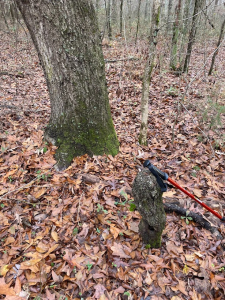
Five hundred years ago, Leonardo da Vinci understood Nature:
There is no result in nature without a cause; understand the cause and you will have no need of the experiment.
When I encounter tree form curiosities and oddities, I seek to understand the cause. Wandering woodlands is far from a brainless exercise, especially when I endeavor to interpret what I see via these photo-essays. Here is another such oddity we spotted. The sweetgum lost its top 15-20 years ago at about six feet. The opening at its right base reveals that the old tree stood hollow, weakened, and subject to breakage from wind. My forensic forestry concludes that the tree suffered that consequence long enough ago that the fallen top has since decayed and incorporated into the forest floor. The hollowed snag retained life sufficient to sprout two stems (right and left rim) to sustain some level of vigor, enough to callous the shattered rim. Nature is remarkably resilient. The evolutionary urge or imperative is powerful. Is it worth the struggle for such a seriously impaired individual to survive? Yes, if the effort (the two spouts and their crowns) can produce even one sweetgum seed ball with a single viable seed that finds fertile ground, takes root, and continues the genetic line. Again, always strive to understand the cause!
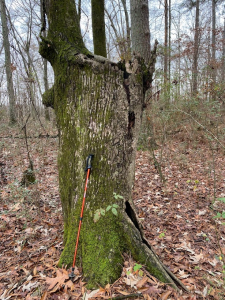
Trail Endings
Water impoundments, cooperative farming, diverse ecosystems, and manifold tree species and forms paint a variable Nature-quilt. Yet, there is more when we seek to discover what lies hidden in plain sight. Like so many facets of Nature, wildlife scat tells a tail. Coyote skat (left) contains telltale fur, perhaps a rodent or larger mammal. Below right, raccoon skat reveals evidence of what had been in our region a bountiful persimmon crop. The tasty sweet fruit holds one-third-inch indigestible seeds that pass through the animal whose digestive acids scarify the tough seeds, encouraging germination when the forager drops them on a surface more suitable than the trail.
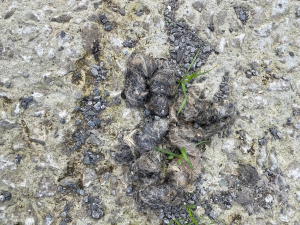
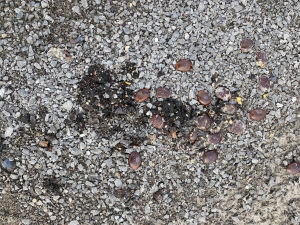
Allow me the liberty of including the skat under the heading of trail endings. Ed and I saw reason to show proof that we had, in fact, made it to the trail’s end.
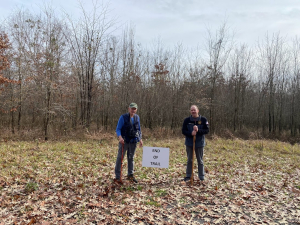
As we returned to our vehicle, clouds thickened to the west, presaging the approaching front. I am seldom satisfied with observing just a single dimension of Nature. I enjoy understanding and appreciating the whole complexion of Nature — land; plants; water; wildlife; and the weather and climate within which life thrives. Our day began in dense stratus overcast and morning fog. As we wandered, the fog cleared and the stratus broke. Now, when exiting, we watched the front grow evident in the west. Never…ever…imprison me in a static climate. Weather diversity is a powerful spice of life for this old forester.
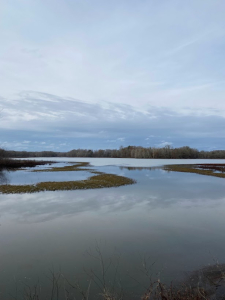
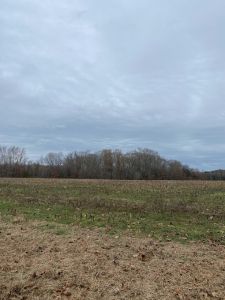
The system’s initial raindrops greeted us as we arrived at our Madison homes. I am blessed to live a location (northern Alabama) where Nature in her varied moods, faces, landscapes, and weather offers abundant beauty, magic, wonder, and awe.
Thoughts and Reflections
I offer these observations:
- Nothing surpasses a gorgeous southern winter day on a new trail crossing through diverse habitat.
- Muir observed eloquently that “Going out…was really going in.”
- Nature willingly shares her secrets and delights with those who seek to see and to understand.
Inhale and absorb Nature’s elixir. May Nature Inspire, Inform, and Reward you!
Note: All blog post images created & photographed by Stephen B. Jones unless otherwise noted. Please circulate images with photo credit: “©2022 Steve Jones, Great Blue Heron LLC. All Rights Reserved.”
Another Note: If you came to this post via a Facebook posting or by an another route, please sign up now (no cost… no obligation) to receive my Blog Post email alerts: http://eepurl.com/cKLJdL
And a Third: I am available for Nature-Inspired Speaking, Writing, and Consulting — contact me at steve.jones.0524@gmail.com
Reminder of my Personal and Professional Purpose, Passion, and Cause
If only more of us viewed our precious environment through the filters I employ. If only my mission and vision could be multiplied untold orders of magnitude:
Mission: Employ writing and speaking to educate, inspire, and enable readers and listeners to understand, appreciate, and enjoy Nature… and accept and practice Earth Stewardship.
Vision:
- People of all ages will pay greater attention to and engage more regularly with Nature… and will accept and practice informed and responsible Earth Stewardship.
- They will see their relationship to our natural world with new eyes… and will understand more clearly their Earth home.
Tagline/Motto: Steve (Great Blue Heron) encourages and seeks a better tomorrow through Nature-Inspired Living!
Steve’s Three Books
I wrote my books Nature Based Leadership (2016), Nature-Inspired Learning and Leading (2017), and Weaned Seals and Snowy Summits: Stories of Passion for Place and Everyday Nature (2019; co-authored with Dr. Jennifer Wilhoit) to encourage all citizens to recognize and appreciate that every lesson for living, learning, serving, and leading is either written indelibly in or is powerfully inspired by Nature.
I began writing books and Posts for several reasons:
- I love hiking and exploring in Nature
- I see images I want to (and do) capture with my trusty iPhone camera
- I enjoy explaining those images — an educator at heart
- I don’t play golf!
- I actually do love writing — it’s the hobby I never needed when my career consumed me
- Judy suggested my writing is in large measure my legacy to our two kids, our five grand kids, and all the unborn generations beyond
- And finally, perhaps my books and Blogs could reach beyond family and touch a few other lives… sow some seeds for the future
All three of my books (Nature Based Leadership; Nature-Inspired Learning and Leading; Weaned Seals and Snowy Summits) present compilations of personal experiences expressing my (and co-author Dr. Wilhoit for Weaned Seals and Snowy Summits) deep passion for Nature. All three books offer observations and reflections on my relationship to the natural world… and the broader implications for society. Order any and all from your local indie bookstore, or find them on IndieBound or other online sources such as Amazon and LifeRich.

